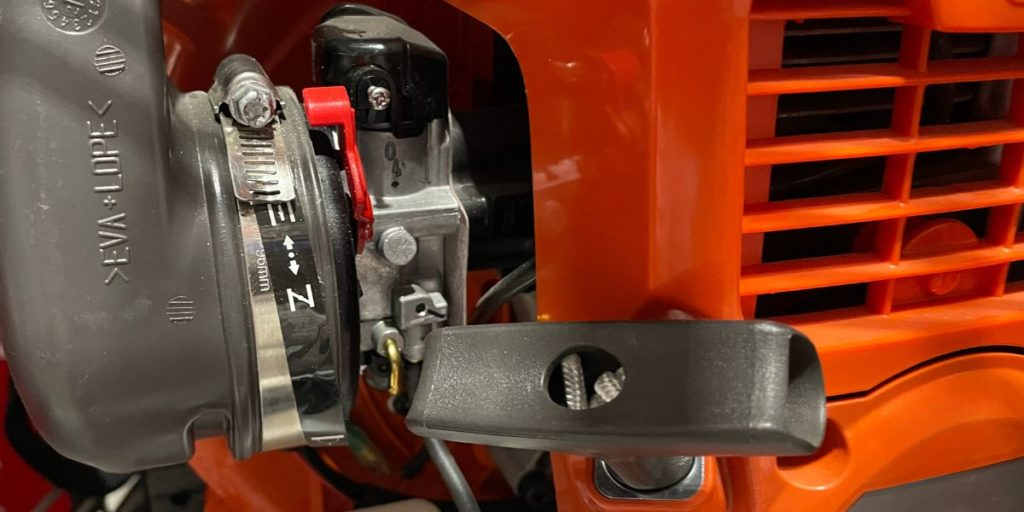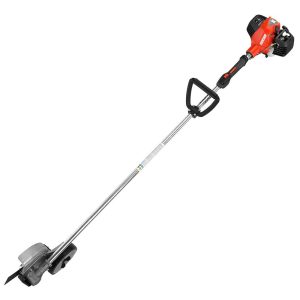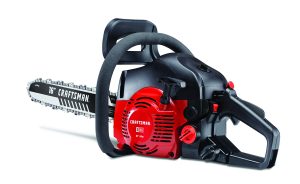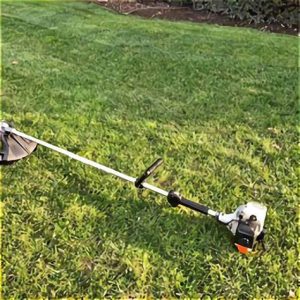Husqvarna’s 13 Most Common Problems When Starting, Running, or Breaking Down: SOLVED IT
When your leaf blower breaks down, it can seem like you’ll never finish the fall cleaning. Having a leaf blower in your arsenal of gardening implements is a must.
Assuming they continue to function as intended, they make leaf cleanup simpler and quicker than with a standard garden rake. When your leaf blower suddenly stops working, I’ll show you where to look and what to do.
Lack of adequate air, fuel, or spark can cause the Husqvarna leaf blower’s engine to start but quickly shut down. The fuel tank vent may be clogged, the fuel may be contaminated, the air filter may be clogged, the spark arrestor may be clogged, the spark plug may be clogged, the carburetor may be clogged, or the air filter may be clogged.
You can find more potential causes of a leaf blower’s demise further down the page. Husqvarna recommends waiting until the engine has cooled and all moving parts have stopped before attempting any maintenance on your blower. Take the time to disconnect the wire from the spark plug as well.

Husqvarna Choke
Before attempting any diagnosis, repairs, or use, make sure you’ve read and fully understood all safety instructions provided in the equipment’s operator’s manual. If you are unsure of how to proceed or if you lack the necessary knowledge or experience, you should seek the assistance of a professional.
Table of Contents
Why Your Husqvarna Leaf Blower Starts, But Then Stops
A Husqvarna Leaf Blower Starts And Then Dies Because of A Wrong Choke Setting.
The amount of fuel used to start a cold engine is much greater than the amount needed to keep it running. In order to do this, the choke must be turned to the on/closed position.
It is necessary to turn the choke to the open position after the engine has warmed up in order to keep the blower operating. A Husqvarna won’t keep running if the choke hasn’t been set properly.
A Clogged Air Filter Makes a Husqvarna Leaf Blower Start Up And Then Stop Working.
A dirty air filter can also prevent air from reaching a Husqvarna blower, resulting in the motor cutting out. The purpose of the air filter is to prevent harmful debris like dirt and dust from entering the carburetor’s throat and damaging the engine.
When using a leaf blower, you create a dirty environment that can clog the filter. Maintaining a clean filter is essential to ensuring that your leaf blower doesn’t stall out or shut off due to a lack of air.
If you use your blower like the typical homeowner, you should replace the air filter once a year and clean it multiple times during the season.
You need to inspect, clean, and replace the filter more frequently if you are using it in extremely dirty environments, for commercial purposes, or more frequently than the average homeowner.
- How to clean the fiber air filter in a Husqvarna blower:
- Take it apart and brush off the dirt to clean it.
- Clean it with a solution of mild dish soap and water if necessary. Wash in running water until residue is gone, then dry flat.
- Clean the air filter housing and cover with a damp cloth before reinstalling.
- If the filter is broken or very dirty, you should get a new one.
- How to Clean a Husqvarna Foam Primary Filter:
- Take out the foam filter from the air filter.
- Remove any lingering grime from the housing and cover with a damp cloth. Keep the air intake free of debris.
- You should clean the foam filter with a mixture of warm water and a mild dish detergent.
- Rinse with clean water until no more soap residue is visible. To dry the filter, ring out any excess water and lay it flat.
- Apply engine oil to the filter, wait for it to dry, and then remove any excess oil. In no way should it be dripping with oil. (Only oil primary foam filters before using them. Do not add oil to your filter if it is a pre-filter that is used in conjunction with a paper air filter. The paper in the filter will get ripped up if you do that.
- Put in the foam air filter.
- Please replace the air filter cover.
- How to wash the paper air filter and foam pre-filter of a Husqvarna backpack blower:
- Take out the air filter and pre-filter.
- If there is any dust or debris left in the air filter’s housing, remove it and clean the cover. Keep the air intake free of debris.
- Wash the foam pre-filter in a solution of mild dish soap and water to get it clean.
- Rinse with clean water until no more soap residue is visible. To dry the filter, ring out any excess water and lay it flat.
- Check the air filter to see if it is still paper. Do not use it if it is dirty; get a new one. In any other case, you can put it to good use again.
- Pre-filter and air filter must be installed and dried.
- Please replace the air filter cover.
When Husqvarna Leaf Blowers Start But Quickly Die, It’s Usually Due To Old Or Contaminated Fuel.
When a leaf blower has been running for a while, it can die from using the wrong fuel or old fuel. To avoid fuel restrictions caused by old gas, it’s best to use the fuel up within 30 days of purchase.
Varnish and gummy substances left behind by aging fuel can reduce fuel flow, reducing blower power and possibly causing it to shut down. With the help of a fuel additive, gas can be used for a longer period of time before it begins to degrade.
An additive that works to keep fuel from deteriorating is found in some 2-cycle oils. Their shelf lives vary widely, from 30 days to 2 years, depending on the maker.
Avoid assuming that oils with a stabilizer will maintain fuel quality for longer than 30 days unless the manufacturer specifically states otherwise.
Sea Foam Motor Treatment is another fuel stabilization option. Make sure you add the right amount of additive to your fuel mix by following the instructions.
Premium 2-cycle engine oil and gasoline are the recommended fuel mixture for Husqvarna 2-cycle leaf blowers. Typically, a 50:1 ratio of gas to oil is used. For more information on how to select and mix fuel for your Husqvarna leaf blower, check out “This Is the Type of Gas and Oil Mix Husqvarna Leaf Blowers Use.”
Gasoline with an octane rating of 89 or higher and no more than 10% ethanol is recommended. To avoid damaging your Husqvarna’s small engine, you should only use fuel with a very low ethanol content or none at all.
A Husqvarna Leaf Blower With A Clogged Fuel Filter Will Start But Quickly Stop Working.
The function of the fuel filter is similar to that of the air filter in that it prevents debris from entering the fuel system. Inside the fuel tank, attached to the fuel line, is the fuel filter, a tiny cylinder-shaped component.
If it isn’t checked and replaced on a regular basis, it can become clogged. Due to a decrease in fuel pressure, the engine may stall or lose power.
The typical homeowner must change out their fuel filter once a year to prevent their vehicle from stalling out due to a clogged filter. More frequent filter inspections and replacements are warranted for heavy use of the Husqvarna.
How to change the fuel filter on a Husqvarna leaf blower:
- To prevent dirt and debris from entering the tank, wipe the area around the fuel cap.
- Take the lid off.
- Take out the fuel tank filter. To retrieve the filter, simply use a clean, bent wire.
- Take the filter out of the fuel line after you’ve taken it out of the tank. The fuel line must not be allowed to fall back into the tank. Holding the fuel line with needle nose pliers can prevent the line from slipping out of your hand and falling back into the fuel tank.
- Plug the male end of the new fuel filter into the fuel line.
- Return the fuel filter to its original location inside the tank.
- Replace the fuel cap.
A Clogged Fuel Line Is To Blame For The Start And Subsequent Shutdown Of A Husqvarna Leaf Blower.
Gummy deposits left behind by old fuel can prevent fuel from freely flowing through the fuel lines. It’s time to get a new Husqvarna fuel line and ditch the old one.
If the fuel line is in relatively good shape, you can try loosening the clog with carburetor cleaner and then blowing it out with compressed air.
If during an inspection you find dry and cracked areas in your fuel lines, you should have them replaced before they start leaking or sucking air into the line from a puncture.
A Husqvarna Leaf Blower Starts Up But Quickly Stops Working Because The Fuel Tank Vent Was Blocked.
Venting is required for the gas tank. It is impossible for air to enter the tank if there isn’t a hole or other opening for it to do so. It prevents gasoline from escaping the tank.
The vent should be checked if fuel flow is inadequate to the carburetor and there is no obstruction in the fuel line or filter.
If your Husqvarna blower died and won’t start, placing it on a flat surface will help you determine if the fuel tank vent is blocked. If you want to start the blower, you need to let air into the tank, so loosen or remove the fuel cap.
Once you’ve checked that the blower starts and runs smoothly, you can secure the fuel cap on the tank. Check to see if the issue reappears and the leaf blower turns off after a short while of use.
If the blower dies and the fuel cap needs to be loosened or removed to get it going again, the fuel vent may be clogged.
Most Husqvarna leaf blowers have a vent in the cap of their gas tanks. You should use a new Husqvarna fuel cap to replace an old one that has become clogged.
A Clogged Carburetor Is The Root Of a Husqvarna Leaf Blower’s Problems.
Your leaf blower won’t fire up or keep running unless the carburetor is adjusted to the proper air-to-fuel ratio. It is possible for the blower to stop working because of clogged passages or malfunctioning small components.
The carburetor often stops working due to stale fuel. You could try cleaning or rebuilding the carburetor to see if that helps. If this does not fix the problem, you will need to replace the carburetor.
A Blocked Cooling System Is To Blame For a Husqvarna Leaf Blower’s Initial Start-Up And Subsequent Demise.
The blower can be set to turn off if the engine temperature gets too high. The Husqvarna engine benefits from having air flow around it to help keep it cool.
Clear the area around the vents and cooling fins of any debris, including grass clippings. First, turn off the engine and wait for the spark plug to cool.
Taking off the engine cover allows you to clean the area around the cylinder and the cover. Remove the engine cover and clean the cylinder fins. Maintaining a clean blower ensures that cool air can flow freely around the engine.
Any debris caught in the grill between the Husqvarna backpack and the blower housing should be cleaned out. Debris should be blown out of the intake and exhaust grills using a handheld blower.
The Husqvarna Leaf Blower’s Carburetor Requires Fine-Tuning.
To ensure optimal performance, Husqvarna adjusts the carburetor settings prior to shipping the blower to the customer. Getting optimal performance from an engine may necessitate adjusting the carburetor settings due to factors like fuel quality and high altitude.
On your Husqvarna leaf blower, you’ll find three screws that can be used to fine-tune the carburetor. To maintain the blower’s idle speed, you may need to adjust the idle speed screw.
The carburetor on a Husqvarna can only be adjusted so far. Carburetor adjustments are a specialty of Husqvarna-trained mechanics, and they keep a special tool on hand for many models.
Bring your leaf blower to your neighborhood Husqvarna dealer if the carburetor continues to cause you trouble for maintenance.
A Husqvarna Leaf Blower With a Faulty Spark Plug Will Start But Quickly Stop Working.
The leaf blower won’t work if the spark plug is dirty or damaged because it won’t produce a steady spark. A lack of consistent spark could render the saw inoperable.
Check the spark plugs to make sure the tip is in good shape. The spark plug needs to be replaced if it is very dark in color, has broken porcelain, or has a burnt electrode.
If the spark plug is only slightly dirty, you can try cleaning it with a wire brush and reusing it. When possible, I just like to get a new one. It’s a cheap maintenance item that’s crucial to your Husqvarna’s operation.
Inspect the spark plug wire connection and the spark plug gap. The leaf blower may turn off for these reasons as well.
A Husqvarna Leaf Blower With a Clogged Spark Arrestor Will Start But Quickly Stop Working.
The leaf blower has a small metal screen that prevents scalding exhaust from ejecting out and striking someone or starting a fire. It is inevitable that carbon buildup on this muffler screen will have an adverse effect on the performance of your vehicle.
Take the wire from the spark plug out. Stop and let the engine cool down. Get to the spark arrestor screen on the Husqvarna blower and take it off carefully. Brush it off with some metal wool.
A new spark arrestor screen should be installed if the old one is too dirty, damaged, or has a hole in it to be effectively cleaned.
Run your blower at full speed on a regular basis to reduce the rate at which carbon accumulates on the spark arrestor. A buildup of carbon is facilitated by allowing your blower to run at low speeds or idle for extended periods of time.
Husqvarna Leaf Blower Ignition Module Not Working.
Now that you know the spark plug is fine, you should make sure the ignition module is working properly. To get your fan going and keep it going, you need an electrical current, which the module supplies to the spark plug.
The windings on the coil are more likely to separate and short out when the coil is hot. When there is an intermittent spark, your Husqvarna leaf blower will lose power, run slowly, or stop running altogether.
If the ignition module is faulty, the spark plug will not receive an adequate voltage.
Husky Leaf Blower Is Experiencing Compression Issues.
There could be a drop in compression as you pull the starter recoil rope. If the Husqvarna leaf blower’s compression isn’t high enough, the machine won’t generate enough pressure to keep going.
Possible causes include damaged pistons, worn crankshaft seals, and worn piston rings.
If your leaf blower needs testing or repairs, you should take it to a small engine mechanic or a Husqvarna dealer.







